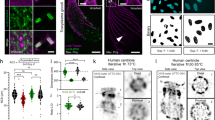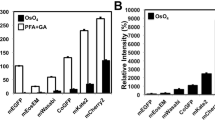Abstract
Super-resolution correlative light and electron microscopy (SR-CLEM) is a powerful approach for imaging specific molecules at the nanoscale in the context of the cellular ultrastructure. Epon epoxy resin embedding offers advantages for SR-CLEM, including ultrastructural preservation and high quality sectioning. However, Epon embedding eliminates fluorescence from most fluorescent proteins. We describe a photocontrollable fluorescent protein, mEosEM, that can survive Epon embedding after osmium tetroxide (OsO4) treatment for improved SR-CLEM.
This is a preview of subscription content, access via your institution
Access options
Access Nature and 54 other Nature Portfolio journals
Get Nature+, our best-value online-access subscription
$29.99 / 30 days
cancel any time
Subscribe to this journal
Receive 12 print issues and online access
$259.00 per year
only $21.58 per issue
Buy this article
- Purchase on Springer Link
- Instant access to full article PDF
Prices may be subject to local taxes which are calculated during checkout


Similar content being viewed by others
Data availability
Plasmids of Mito-mEosEM, mEosEM-Lamin A and pRSET-mEosEM used in this study are available from Addgene with accession codes 132706, 132707 and 132708, respectively. A step-by-step Supplementary Protocol for the super-resolution CLEM method described in this paper is available on Protocol Exchange (https://doi.org/10.21203/rs.2.13841/v1)27. Source data for Fig. 1a,c,d are available with the paper online. Other data that support the findings of this study are available from the corresponding author upon request.
Code Availability
The PALM algorithm used for SR image reconstruction in LM is available from the corresponding author upon request.
References
Wells, B. & La Cour, L. F. J. Microsc. 93, 43–48 (1971).
Glauert, A. M. in Techniques for Electron Microscopy (ed. Kay, D) 254–310 (Blackwell, 1965).
Betzig, E. et al. Science 313, 1642–1645 (2006).
Watanabe, S. et al. Nat. Methods 8, 80–U117 (2011).
Polishchuk, R. S. et al. J. Cell Biol. 148, 45–58 (2000).
Polishchuk, R. S., Polishchuk, E. V. & Luini, A. Methods Cell Biol. 111, 21–35 (2012).
Kukulski, W. et al. J. cell Biol. 192, 111–119 (2011).
Sartori, A. et al. J. Struct. Biol. 160, 135–145 (2007).
Chang, Y. W. et al. Nat. Methods 11, 737–739 (2014).
Tokuyasu, K. T. J. Cell Biol. 57, 551–565 (1973).
Kopek, B. G., Shtengel, G., Xu, C. S., Clayton, D. A. & Hess, H. F. Proc. Natl Acad. Sci. 109, 6136–6141 (2012).
Johnson, E. et al. Sci. Rep. 5, 9583 (2015).
Walther, P. & Ziegler, A. J. Jom J. Microsc. 208, 3–10 (2002).
Paez-Segala, M. G. et al. Nat. Methods 12, 215 (2015).
Schaff, Z., Heine, U. & Dalton, A. Cancer Res. 32, 2696–2706 (1972).
Bykov, Y. S., Cortese, M., Briggs, J. A. & Bartenschlager, R. FEBS Lett. 590, 1877–1895 (2016).
Luft, J. H. J. Cell Biol. 9, 409–414 (1961).
Xiong, H. et al. Nat. Commun. 5, 3992 (2014).
Xu, C. S. et al. eLife 6, e25916 (2017).
Chudakov, D. M. et al. Nat. Biotechnol. 22, 1435–1439 (2004).
Subach, O. M. et al. Nat. Methods 8, 771–U125 (2011).
Zhang, X. et al. Proc. Natl Acad. Sci. USA 113, 10364–10369 (2016).
Costantini, L. M., Fossati, M., Francolini, M. & Snapp, E. L. Traffic 13, 643–649 (2012).
Kopek, B. G. et al. Nat. Protoc. 12, 916–946 (2017).
Zhang, M. et al. Nat. Methods 9, 727–729 (2012).
Paul-Gilloteaux, P. et al. Nat. Methods 14, 102 (2017).
Xu, Pingyong et al. Protoc. Exch. https://doi.org/10.21203/rs.2.13841/v1 (2019).
Acknowledgements
This project was supported by the National Key R&D Program of China (2016YFA0501500 to P.X. and 2017YFA0505300 to M.Z.), the National Natural Science Foundation of China (31421002 and 21778069 to P.X., 31670870 and 31870857 to M.Z. and 31730054 to T.X.), the Project of the Chinese Academy of Sciences (XDB08030203 to P.X.), the Project of Chinese Academy of Sciences-Peking University Leading Cooperation Team (P.X. and T.X.), the Beijing Municipal Science & Technology Commission, project no. Z181100004218002 (T.X.). We thank M. G. Sun at Janelia Farm Research Campus, USA, for kind suggestions on the EM sample preparation and CLEM imaging. We thank the Center for Biological Imaging at the Institute of Biophysics for support with EM and confocal imaging.
Author information
Authors and Affiliations
Contributions
P.X., T.X. and M.Z. designed research. Z.F., D.P., M.Z., F.X. and R.Z. performed research. W.H. set up the imaging microscope. P.X., T.X. and M.Z. analyzed the data and wrote the paper.
Corresponding authors
Ethics declarations
Competing interests
A Chinese patent application (application no. 201910486631.1) covering the use of mEosEM for CLEM and fluorescent microscopy has been filed in which the Institute of Biophysics, Chinese Academy of Sciences is the applicant, and P.X., T.X., M.Z., Z.F. and D.P. are the inventors.
Additional information
Peer review information Rita Strack was the primary editor on this article and managed its editorial process and peer review in collaboration with the rest of the editorial team.
Publisher’s note Springer Nature remains neutral with regard to jurisdictional claims in published maps and institutional affiliations.
Integrated supplementary information
Supplementary Figure 1 The fluorescence retention of cells expressing H2B-mEos4b upon osmic acid fixation.
a, Fixed CHO cells (4% PFA+ 2.5% GLUT) expressing H2B-mEos4b imaged by wide-filed microscopy with a 10 × air objective. b, The same filed-of-view (FOV) of a after 1% OsO4 fixation. Arrows indicating five cells with gradually decreasing fluorescence. c, The fluorescent intensity of the five cells in a before 1% OsO4 fixation. d, The fluorescent intensity of the five cells in c after 1% OsO4 fixation. Scale bar is 100 µm.
Supplementary Figure 2 Comparison of the green fluorescent intensity of H2B-mEos3.2 and H2B-mEos3.2-M overexpressed in U2OS cells 24 h after transfection.
Pair-wised two-tailed t-test was performed. Bars represent mean ± s.d., n = 30 cells.
Supplementary Figure 3 The amino acid and DNA sequences of mEosEM.
a, The amino acid sequences alignment of mEosEM and mEos4b. Mutation sites of mEosEM are highlighted in black boxes. b, The DNA sequence of mEosEM.
Supplementary Figure 4 The thermal stabilities of PCFPs.
a, The green fluorescence thermal stability of purified mEosEM, mEos4b and intermediate mutants (~2.5µg/ml) were measured at 60 °C in Rotor-Gene 6600 real-time PCR cycler. b, The structure stability of purified mEosEM, mEos4b and other mutants with a concentration of 0.05 mg/ml in 100 mM phosphate-buffered saline (PBS, pH 7.2) measured during thermal denaturation by circular dichroism at 200 nm. The experiments of a and b were performed three times with similar results.
Supplementary Figure 5 The osmium acid resistance of PCFPs in the green state.
a, The fluorescence intensity of PCFPs in the green state without osmium acid treatment (shaded) and with 1% OsO4 incubation for 15 min (empty). All groups have the same concentration of purified fluorescent protein (0.125 mg/ml). Bars represent mean ± s.d., n = 3 independent experiments. b, Comparison of fluorescence retention ratio of PCFPs in the green state after OsO4 treatment. Bars represent mean ± s.d., n = 3 independent experiments.
Supplementary Figure 6 Spectral properties, pH sensitivity and photostabilities of mEosEM.
a, Absorption spectra of mEosEM. The absorption peak of mEosEM is at 504 nm. b, Excitation and emission spectra of mEosEM in the green state. The excitation peak and emission peak of mEosEM are at 503 nm and 513 nm, respectively. c, Excitation and emission spectra of mEosEM in the red state. The excitation peak and the emission peak of mEosEM are at 569 nm and 579 nm, respectively. d, The pH sensitivity of mEosEM in the green state. The fluorescence intensity of mEosEM was plotted against the pH and fitted using Equation 1 (described in Methods). The calculated pKa is 6.0. e, The pH sensitivity of mEosEM in the red state. The fluorescence intensity of mEosEM was plotted against the pH and fitted using Equation 1 (described in Methods). The calculated pKa is 6.5. The experiments of a-g were performed three times with similar results. f, Photobleaching curves of mEosEM and mEos4b in the green state. Fluorescence intensity was plotted against time and presented as the mean ± s.d., n = 6 cells. Illumination intensity (488-nm light), 3 W/cm2. g, Photobleaching curves of mEosEM and mEos4b in the red state. Fluorescence intensity was plotted against time and presented as the mean ± s.d., n = 5 cells. Illumination intensity (561-nm light), 300 W/cm2. h, Statistics of the time when the green fluorescence decreased to half of its original signal. Bars represent mean ± s.d., n = 6 cells. Pair-wised two-tailed t-test was performed. i, Statistics of the time when red fluorescence decreased to half of its original signal. Bars represent mean ± s.d., n = 5 cells. Pair-wised two-tailed t-test was performed.
Supplementary Figure 7 Monomeric and fusion properties of mEosEM.
a, Size-exclusion chromatography of purified mEosEM and mEos4b (10 μM). b, Presentation of OSER assay of mEosEM. Left, normal structure of CytERM-mEosEM. Right, abnormal structure of CytERM-mEosEM. The white arrow indicates the whorl structure. Scale bars, 15 μm. The OSER assay1 of mEosEM showed that 97% of the cells exhibited normal CytERM structures (without nuclear envelope thickenings, whorl structures), n = 1532 cells. c, Sedimentation velocity analytical ultracentrifugation of mEosEM and mEos4b proteins (0.05 mM). The theoretical molecular weight of monomeric of mEosEM and mEos4b with a 6 × His tag is approximately 30 kD. d, Confocal images of mEosEM-labeled structures. Lamin A (i), H2B (ii), F-actin (iii), mitochondria (iv), CytERM (v) and caveolin (vi). Scale bars, 10 μm. The experiments of a, b and d were performed three times with similar results. 1. Costantini, L.M., Fossati, M., Francolini, M. & Snapp, E.L. Assessing the Tendency of Fluorescent Proteins to Oligomerize Under Physiologic Conditions. Traffic 13, 643-649 (2012).
Supplementary Figure 8 Single molecule characteristics of mEosEM for SMLM imaging in Epon-embedded section.
a, Distribution of photon number and localization precision of mEosEM in five individual cells. b, Statics of total photon number, localization precision and single molecule SNR of mEosEM. Bars represent mean ± s.d., n = 5 cells.
Supplementary Figure 9 The effect of alkaline buffer on the EM structure of GMA- and Epon-embedded samples.
a, GMA-embedded samples without treatment. b-e, GMA-embedded samples treated with alkaline buffer with pH ranging from 7.4 to 10. f, Epon-embedded samples without treatment. g-j, Epon-embedded samples treated with alkaline buffer with pH ranging from 7.4 to 10. Scale bars, 500 nm. The experiments of a-j were performed three times with similar results.
Supplementary Figure 10 SR-CLEM images of Durcupan embedded section.
SR CLEM images of a 100-nm Durcupan section of a CHO cell expressing mitochondria targeted by mEosEM. Scale bar is 2 µm. Arrow heads: gold nanoparticles. This experiment was performed three times with similar results.
Supplementary Figure 11 The PALM and EM image registration procedure and error.
a, EM image showing the landmark positions. b, FM image showing the landmark positions. c, Overlaid EM and FM images after registration. d, The whole predicted error map generated by eC-CLEM using 9 landmarks. e, Registration error by leave-one-out cross validation (LOOCV) of 9 landmarks. The experiments of a-e were performed three times with similar results.
Supplementary information
Supplementary Information
Supplementary Figure 1–11, Supplementary Tables 1–4.
Source data
Rights and permissions
About this article
Cite this article
Fu, Z., Peng, D., Zhang, M. et al. mEosEM withstands osmium staining and Epon embedding for super-resolution CLEM. Nat Methods 17, 55–58 (2020). https://doi.org/10.1038/s41592-019-0613-6
Received:
Accepted:
Published:
Issue Date:
DOI: https://doi.org/10.1038/s41592-019-0613-6
This article is cited by
-
Accelerating data sharing and reuse in volume electron microscopy
Nature Cell Biology (2024)
-
In-resin CLEM of Epon-embedded cells using proximity labeling
Scientific Reports (2022)
-
Chemically stable fluorescent proteins for advanced microscopy
Nature Methods (2022)
-
Plant multiscale networks: charting plant connectivity by multi-level analysis and imaging techniques
Science China Life Sciences (2021)
-
Cryogenic superresolution correlative light and electron microscopy on the frontier of subcellular imaging
Biophysical Reviews (2021)



